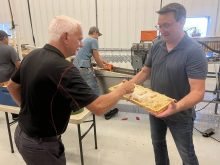GRANUM, Alta. – When the Granum School faced closure in 1992, help arrived in a Volkswagen van.
The driver, Stephen Harris, was the new principal and he introduced his ideas to save the school with an innovative teaching method known as multi-aging.
For the village south of Claresholm, the concept delivered by the bearded, bushy haired teacher seemed risky, but enough people were willing to try if it meant keeping their rural school open.
“The parents at the time saw that they had to do something very innovative or they were going to lose their school and a very brilliant educator came to be principal at Granum at just the right time. He helped them transform their school,” said Denise Calderwood.
Read Also

Understand limitation periods if considering civil suit
A limitation period refers to the amount of time a plaintiff has to commence a formal claim in court or lose their ability to pursue it.
That story was captured on film by Calderwood who ranches with her husband Jim a few kilometres from Granum.
Called The Little School That Could, this was the second documentary for Calderwood, who studied film making at the Galliano Film School on Salt Spring Island in 2003.
The film features interviews with students, teachers, parents and administrators who slowly bought into the concept of a gradeless school.
Children were split into three divisions of Grades 1 to 3, 4 to 6 and 7 to 9. The students work at their own pace and make choices in completing the Alberta curriculum. Behaviour problems are minimal and children thrived who had previously struggled with the traditional grade concept. The school applied to have open boundaries so children from outside the Livingstone Range School Division could attend. They could also be bused out of the community to a more traditional school.
Every child has a laptop computer and high speed internet connections are available for enhanced studies.
Calderwood’s children attended the school before this concept was introduced but she was a longtime volunteer and interested community supporter. She became so enthralled with the idea that she was determined to record its successes and frustrations on film. She also wants the film to inspire other communities in danger of losing their schools.
“This story is a way to convey all sorts of things about your culture and your life and your community,” she said.
The story is also analogous with her life where she was willing to take a risk and step into the unknown because she was not content to stay home and retire.
The Granum school story was mostly self-financed at $14,000 and took two years to complete, including the time it took to convince teachers and students to agree to participate in her production. Calderwood worked two part-time jobs to pay for it and collaborated with a camera man from Global Television in Lethbridge. He had a private editing studio and together they reduced 21 hours of footage to a 48 minute package.
Global Lethbridge has agreed to air the documentary and she plans to enter it in Calgary and Edmonton film festivals.
Growing up in Vancouver, Calderwood was a voracious reader and eventually became a teacher with a masters degree in international education. Her stories on film are one way to educate others as well as fulfil her own need to create.
“At this stage in my life I would like to tell a few good stories.”
Her film company is called Chinook Fire Productions and she is working on getting a broadcast licence. With a licence and a growing list of contacts, financing could be easier.
Her first film was a half hour feature called Tobiji, She Journeyed With Them. It focuses on her aunt who was a nurse to Japanese detainees during the Second World War on the West Coast. When the camps were dispersed, she accompanied 105 people sent by train through interior British Columbia to a sanatorium for tuberculosis treatment. This little known piece of history was captured on film and is now in some Japanese Canadian archives in Toronto, Burnaby and Lethbridge.
Calderwood has more documentary proposals in the works including an idea about a local baseball team from bygone years as well as a piece on the environmental impacts of oil and gas exploration in southwestern Alberta.
With two completed works, she is starting to meet a network of filmmakers, from the National Film Board to women’s film groups. She is also going back to film school this fall.
Like any diversification project, she must find ways to sell her product and her proposals for other films. Marketing is a greater challenge than production, but she is learning as she goes. One sales opportunity was an invitation to pitch an idea before production executives at the Banff International Television Festival.
“I was absolutely terrified. This was the big leagues,” Calderwood said.
As she gains experience and stature as a film maker, she wants to pursue stories from her own life.
“There are good stories that need to be told and are great benefit to our society. Often the best place is in your own backyard.
“A good story, whatever it is, draws us in and gives us some insight.”

















